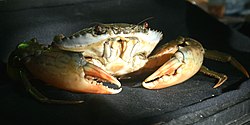| Scylla paramamosain | |
|---|---|
 | |
| Green mud crab, Scylla paramamosain from Bekasi, West Java, Indonesia | |
| Scientific classification | |
| Kingdom: | Animalia |
| Phylum: | Arthropoda |
| Class: | Malacostraca |
| Order: | Decapoda |
| Suborder: | Pleocyemata |
| Infraorder: | Brachyura |
| Family: | Portunidae |
| Genus: | Scylla |
| Species: | S. paramamosain |
| Binomial name | |
| Scylla paramamosain Estampador, 1949 | |
Scylla paramamosain is a mud crab commonly consumed in Southeast Asia.
